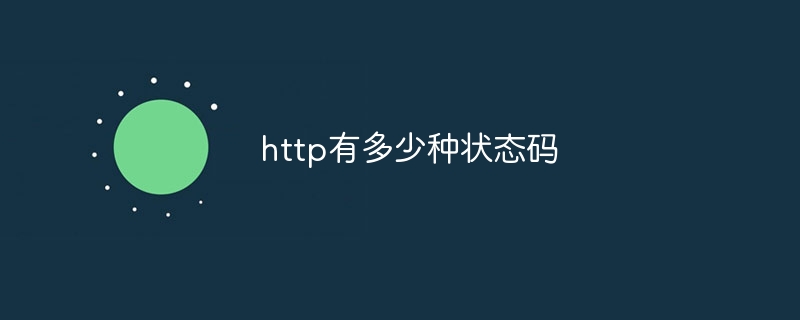
http has 27 status codes, namely 100, 101, 200, 201, 202, 204, 206, 300, 301, 302, 303, 304, 307, 308, 400, 401, 403, 404 , 405, 408, 429, 500, 501, 502, 503, 504 and 505. Detailed introduction: 1. 100 Continue, indicating that the client can continue to send requests, usually used for request headers containing Expect: 100-continue, etc.

The operating system for this tutorial: Windows 10 system, DELL G3 computer.
HTTP (Hypertext Transfer Protocol) is a protocol used to transmit data on the Web. It defines a series of status codes used to represent the server's response to client requests. HTTP status codes consist of three digits, and each status code has a specific meaning. Currently, there are five types of HTTP status codes, namely 1xx, 2xx, 3xx, 4xx and 5xx, which include a variety of different status codes. The following is a detailed explanation of the HTTP status code:
1xx - Informational (Informational status code):
1.100 Continue: Indicates that the client can continue to send requests. Usually used when the request header contains Expect: 100-continue.
2.101 Switching Protocols: Indicates that the server is switching protocols, such as HTTP to WebSocket.2xx - Success (success status code):
3. 200 OK: Indicates that the request is successful. The server successfully processed the request and returned the requested resource.
4. 201 Created: Indicates that the request was successful and the server created a new resource.
5. 202 Accepted: Indicates that the request has been accepted, but has not been processed yet.
6. 204 No Content: Indicates that the request is successful, but the response does not contain any content. It is usually used when there is no need to return the body.
7. 206 Partial Content: Indicates that the server has successfully processed part of the request, usually used for segmented downloads.
3xx - Redirection (redirection status code):
8. 300 Multiple Choices: Indicates that there are multiple choices for the resource requested by the client, and further operations are required to select the resource.
9. 301 Moved Permanently: Indicates that the requested resource has been permanently moved to a new URL.
10. 302 Found: Indicates that the requested resource has been temporarily moved to a different URL.
11. 303 See Other: Indicates that the server recommends that the client access another URL, usually used for redirection after a POST request.
12. 304 Not Modified: Indicates that the resource has not been modified and the client can use the cached version.
13. 307 Temporary Redirect: Similar to 302, it indicates that the resource has been temporarily moved to a different URL, but the client is required to maintain the original HTTP request method.
14. 308 Permanent Redirect: Similar to 301, it indicates that the resource has been permanently moved to a new URL, requiring the client to maintain the original HTTP request method.
4xx - Client Errors (client error status code):
15. 400 Bad Request: Indicates that the client's request is invalid or illegal.
16. 401 Unauthorized: Indicates that the request requires user authentication. Valid credentials are usually required in the request.
17. 403 Forbidden: Indicates that the server rejected the request. The client does not have permission to access the requested resource.
18. 404 Not Found: Indicates that the requested resource was not found.
19. 405 Method Not Allowed: Indicates that an HTTP method is not allowed in the request.
20. 408 Request Timeout: Indicates that the client request has timed out.
21. 429 Too Many Requests: Indicates that the client sends requests too frequently and reaches the server limit.
5xx - Server Errors (server error status code):
22. 500 Internal Server Error: Indicates that the server encountered an unhandled error.
23. 501 Not Implemented: Indicates that the server does not support the function requested by the client.
24. 502 Bad Gateway: Indicates that the server received an invalid response as a gateway or proxy.
25. 503 Service Unavailable: Indicates that the server is currently unable to process the request, usually due to maintenance or overload.
26. 504 Gateway Timeout: Indicates that the server as a gateway or proxy times out while waiting for a response from the upstream server.
27. 505 HTTP Version Not Supported: Indicates that the server does not support the HTTP protocol version requested by the client.
In summary, the HTTP status code is used to indicate the server's response to the client's request. Different status codes have different meanings, helping developers understand whether the request was successful, whether a redirection was required, whether there was a client error or a server error, etc. Proper handling of these status codes is important for building robust web applications to ensure users get the correct information and response.
The above is the detailed content of How many status codes does http have?. For more information, please follow other related articles on the PHP Chinese website!




